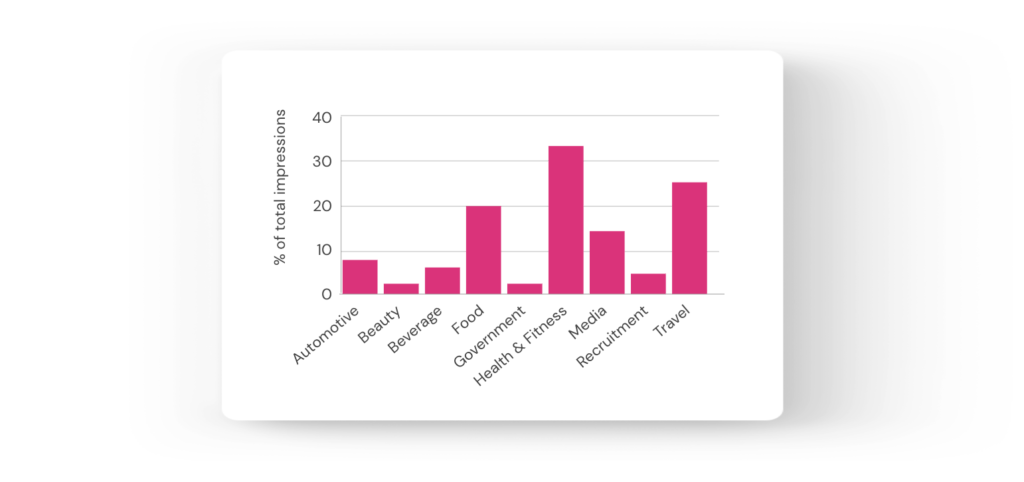The name of the game is behavioral intelligence: a layer of intelligence that enriches your inventory with live and behavior-based audience insights. Early adopters like Australian audio conglomerate Southern Cross Austereo (SCA) are seeing strong advertiser demand for their context-enriched inventory, with a 25% MoM uptake in impressions.
Advertising Intelligence in 2023
Here’s how it works. Say you’re Spotify. Rather than just serving a Nike ad for running shoes to people who listen to health-related podcasts or gym playlists, as you may do today, you can now serve it to users who are currently running, or users who just came home from a run.
Not only does that allows Nike to reach a more relevant audience (not everyone who listens to health-related podcasts needs running shoes, after all) – it also allows them to personalize the creative for each live behavioral persona, to suggest how this product may fit into their life.
But before I get carried away talking about adtech innovations, let’s take a step back. To understand how behavior-based intelligence can allow you to win premium brands and campaign budgets, let’s first take a look at what advertisers want – and then review how you can position your inventory to deliver on that.
What Brands Want (or: How to Tell a Good Story)
On average, we’re exposed to over 6,000 ads a day. If brands want to create memorable ad experiences, they have to find a way to cut through the noise – which is one of the reasons why attention metrics have gained rapid popularity among brands.
One of the key tactics that brands use to deliver on these metrics is storytelling. Stories are fundamentally more engaging to our brain than logical statements (because humans think narratively rather than argumentatively) – however, a story that resonates deeply with one person, can go unnoticed by another.
In other words: the greatness of a story is subjective. An ad for a laundry detergent that can remove pet paw stains from my clothes will probably resonate if I’m a pet owner, but is unlikely to grab my attention if I’m not. It seems obvious – yet more often than not, my laundry ads star a mom washing kids’ clothes. For reference, I have exactly zero children. Do people without kids not do laundry? And what about men? Do men not do laundry?
Good stories invite their audience to be the hero.
In order to write such stories, we first have to know who our audience is. We found that 3 types of information are particularly useful, here: who, why and when. Let’s illustrate this with an example.
- Who might need laundry detergent?
- Pet owners
- Gym-goers
- Why do they need laundry detergent?
- Pet owners often find themselves covered in paw prints; they need laundry detergent so they can play with their pets without having to worry about their clothes
- Gym-goers need to wash their gym outfit multiple times a week; they need a laundry detergent that allows them to remove all odors on a short cycle / cold wash
- When would they be most receptive to a laundry detergent ad?
- Pet owners: after they played with their pet (or walked their dog)
- Gym-goers: while unwinding after a gym session
TLDR: In order to tell stories that resonate, advertisers have to make their audience the hero of their story. The more publishers can tell a prospective advertiser about their audience – who might need their product, why they might need it, and when they would be most receptive to the ad – the easier it is for them to find the right match (and for you to seal the deal).
Giving Brands What They Want
Now, you may be thinking, it’s all well and good that granular audience insights can draw in major brands – but I don’t have such data, and even if I could get my hands on it, that doesn’t sound like it would be privacy compliant.
Meet Euclid. It’s a pretty nifty piece of technology (if we say so ourselves) that intelligently combines data from device sensors to create behavior-based cohorts such as Pet Owners and Gym-Goers, and predicts live moments such as walking, outside, or at the gym. Since the computations happen on the user’s device inside the app, the solution is private by design.
Let’s take a look at how Southern Cross Austereo, one of Australia’s largest audio conglomerates, has put it to use.
A Case Study: Southern Cross Austereo
Since integrating Euclid in July 2022, SCA grew its Euclid-enriched ad impressions by an average of 25% MoM. Their advertisers are coming from a broad variety of verticals, with particular interest from Health & Fitness, Travel, and Food.

Advertisers bought over 27 different cohorts and moments in the first 6 months. Health & Fitness brands bought Cardio Champions, Early Risers, Walkers and Joggers, while Media brands optimized for attention spans by buying In Vehicle, Walking, Working and Joggers. Alcoholic beverage brands connected with those who don’t have to drive, by targeting the Work from Home cohort and people currently Working at Home.
“The ability to offer hyper-targeted campaigns without the need for PII or identifiers is groundbreaking. NumberEight allows us to offer advertisers live, in-moment targeting and audience insights at scale that drive business outcomes.“
– Brian Gallagher, Chief Sales Officer, SCA
Which cohorts and moments would help you attract the advertisers you’re after? And which ones would help you win bigger budgets from current advertisers? To see a list of all available signals, download Euclid’s full taxonomy. You can also book a demo to see how on-device intelligence works and get onboarded.










